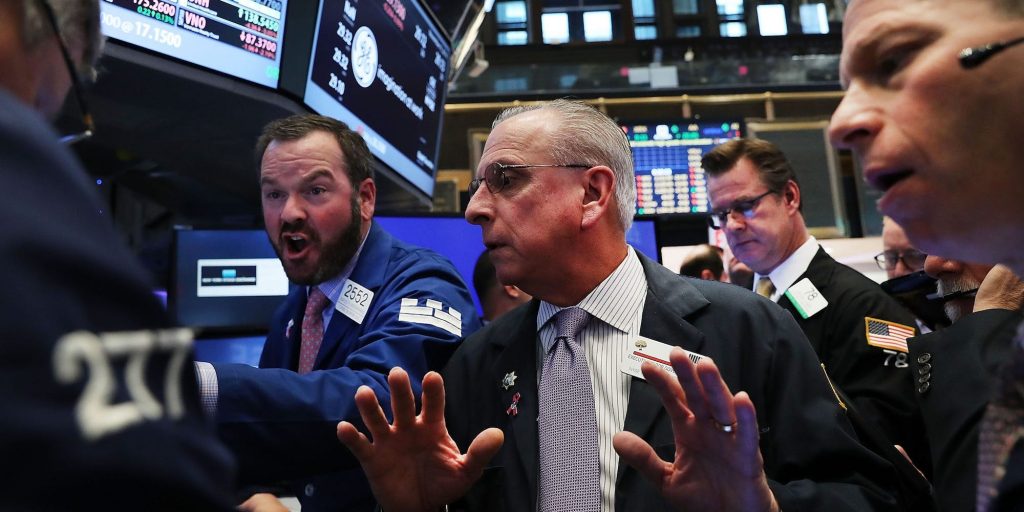- Peter Cecchini is warning that stocks probably have further to fall.
- In a recent note, he laid out the top four threats to the market right now.
- Stocks rallied almost 7% this week after falling 13% to start the year.
In January, Peter Cecchini was already bearish on the stock market’s prospects for three reasons.
There was the fact that inflation was continuing to run rampant, threatening to derail the economic expansion with rising costs hurting consumer sentiment.
On the other edge of that sword was the developing realization among investors that the Federal Reserve would likely have to tighten policy with more gusto than had been expected to cool down rising prices — also risking putting the economy into recession by dampening growth.
Lastly, the hope for any more fuel for the fire from the fiscal policy side of the equation had also died out as moderate Democrats and Republicans blocked further spending bills that President Joe Biden was eager to sign.
This trio of factors has weighed on market sentiment since then, with the S&P 500 having falling as much as 13% since the start of the new year.
And according to Cecchini, the director of research at the hedge fund Axonic, all of them still create significant risk for stocks.
The only thing that's changed is that a fourth major threat has materialized in the war in Ukraine, Cecchini said in a note to clients on Thursday. Russia's invasion of Ukraine has thrown a wrench into global supply chains, and has sent the price of oil surging to historic highs, further fueling inflation around the world.
In the note, Cecchini warned that the threat of a recession this year is growing, citing three major recession triggers that are currently acting in unison.
"The presence of at least one of three ingredients often leads to recession: Fed tightening (perhaps in response to inflation or asset price bubbles), commodity price shocks, or systemic financial market disruptions," Cecchini wrote.
"The Fed is tightening. What's quickly evolving into an oil price shock will only exacerbate the tension the Fed faces between inflation and unemployment. Finally, the unintended consequences on the global financial system of sanctioning a $1.7 trillion economy are unclear," he continued. "Thus, there's now a good chance all three could happen at once."
With these risks in mind, Cecchini recommends lessening exposure to stocks and using any rallies as an opportunity to sell positions. He said that, despite the correction so far this year, the S&P 500 is likely to still see a larger pullback over the longer term. He cited two environments with similar elements to today's circumstances: 2018, when investors sold stocks as a result of Fed tightening, and the 1970s, when rising oil prices and a stagflation led to multiple stock market corrections.
Cecchini also highlighted that stock valuations are still relatively high, with the S&P 500's price-to-sales ratio near three. For context, the market's average price-to-sales ratio over the last 20 years has been 1.7.
"Unfortunately, even after the already considerable drawdowns in US equity and high yield markets, a more substantial equity and high yield corporate credit de-risking is probably in the cards," he said. "When it comes to large caps, buying the dip still doesn't equate to buying value. Even after the recent correction, the S&P 500 still trades at 3x revenues! The remainder of the equity market is positioned even more poorly for inflation than the stalwarts of the S&P."
Cecchini's views in context
Cecchini's call for a continued sell-off in stocks and recommendation to use rallies to sell comes at an interesting time.
After some of the most bearish trading sessions since March of 2020 in recent weeks, stocks have finally started to stage a comeback. The S&P 500 is up nearly 7% since Monday, stringing together multiple positive days.
But it remains to be seen if the selling has stopped. Peace talks between Russian and Ukraine appear to be unlikely in the days ahead, and a drawn out conflict could continue to put stress on the global economy.
Two of JPMorgan's top economists, Bruce Kasman and Joseph Lupton, said in a note on Friday that the risk of a recession this year has increased in part because of the conflict.
"The most significant immediate threat to the global economy comes from a sustained shut-off of Russian energy exports to the West, which could push Brent crude oil prices above $150/bbl and poses particular risk to Europe due to its dependence on Russia for natural gas," Kasman and Lupton wrote. "Our analysis suggests that this event could push Euro area CPI inflation to 10%oya later this year."
The effect of tightening monetary policy on GDP and earnings growth is likely to continue to weigh on stocks going forward, according to Mike Wilson, Morgan Stanley's chief US equity strategist. Wilson has a 2022 S&P 500 price target of 4,400. It closed Friday at 4,463.
Goldman Sachs' David Kostin also cited tightening policy, alongside geopolitical tensions, as reasons for lowering his 2022 price target by 200 points to 4,700.
And a number of Wall Street experts — including former Fed advisor Danielle DiMartino Booth and Brown Advisory's Tom Graff — say the Fed will have to stay on its tightening path despite the war in Ukraine.
Still, many remain bullish on stocks, including JPMorgan's top strategist, Marko Kolanovic. He said on Thursday that there are "great opportunities" in areas of the market given widespread selling in recent months, and that a recession is unlikely this year. The bank's top US equity strategist, Dubravko Lakos-Bujas, has a 2022 price target of 5,050 on the S&P 500.
Other bulls on Wall Street include BMO's Brian Belski (price target of 5,300) Deutsche Bank's Binky Chadha (5,250), and Credit Suisse's Jonathan Golub (5,200). David Hunter, the chief macro strategist at Contrarian Macro Advisors, also told Insider last week that current investor sentiment is overbearish, and improving investor confidence should contribute to a rally in the months ahead.
It's an uncertain time for investors. Protracted selling to start the year may set the market up to resume its record bull run in the remainder of 2022.
But as risks remain — namely the war in Ukrain, climbing inflation, and the Fed trying to stop rising prices without pushing the economy into recession — investors might do well to keep in mind Cecchini's warning that selling could continue.

